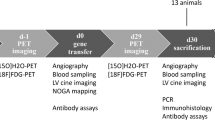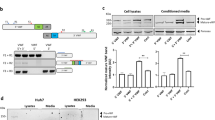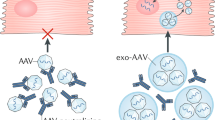Abstract
Patients usually have serious complications of thrombosis and bleeding by eating anticoagulation medicine for their residual lives after mechanical valve replacement operation. Tissue-type plasminogen activator (tPA) could target thrombolysis by activating plasminogen to fibrinolysin. In this study, we recombined a retroviral vector pLEGFP-N1-tPA and cultured purified packaging cells PT67/pLEGFP-N1-tPA to produce high-titer retrovirus. In vitro, two target cells, endothelial cell of umbilical vein (ECUV) 304 and heart muscle cell (HMC) that consist of endocardium and heart muscle, were infected by pLEGFP-N1-tPA. The results demonstrated that exogenous tPA was successfully transferred into ECUV304 and HMC. tPA in the two cells shows significant thrombolysis in plasma plate and the activity and content of tPA were high. Furthermore, in vivo, no thrombus was seen on the surface of Dacron patches (the same material making up a ring of mechanical valve) by tPA locally transferring around Dacron patches that were transplanted in the inferior caval veins of rabbits. tPA was successfully transferred into the local inferior caval vein. Activity and content of tPA were high in local tissue and blood and thrombolysis was effectively demonstrated by tPA rapidly, efficiently and long expressing. This laid the foundation for study and appliance of the tPA gene valve.
This is a preview of subscription content, access via your institution
Access options
Subscribe to this journal
Receive 12 print issues and online access
$259.00 per year
only $21.58 per issue
Buy this article
- Purchase on Springer Link
- Instant access to full article PDF
Prices may be subject to local taxes which are calculated during checkout


Similar content being viewed by others
References
Agarwala S, Kumar S, Berridge J, Mclenachan J, O'Regan DJ . Double valve replacement for acute spontaneous left chordal rupture secondary to chronic aortic incompetence. Journal of Cardiothoracic Surgery 2006; 1: 33.
Joseph S, Emanuel R, Sturridge M, Olsen E . Congenital aortic valve disease with rupture of mitral chordae tendinae. Br Heart J 1976; 38: 665–673.
Schelbert EB, Vaughan-Sarrazin MS, Welke KF, Rosenthal GE . Hospital volume and selection of valve type in older patients undergoing aortic valve replacement surgery in the United States. Circulation 2005; 111: 2178–2182.
Florath I, Albert A, Rosendahl U, Alexander T, Ennker IC, Ennker T . Mid term outcome and quality of life after aortic valve replacement in elderly people: Mechanical versus stentless biological valves. Heart 2005; 91: 1023–1029.
Hammermeister K, Sethi GK, Henderson WG, Grover FL, Oprian C, Rahimtoola SH . Outcomes 15 years after valve replacement with a mechanical versus a bioprosthetic valve: final report of the veterans affairs randomized trial. J Am Coll Cardiol 2000; 36: 1152–1158.
Oxenham H, Bloomfield P, Wheatley DJ, Lee RJ, Cunningham J, Prescott RJ et al. Twenty year comparison of a Bjork-Shiley mechanical heart valve with porcine bioprostheses. Heart 2003; 89: 715–721.
Uchiyama S . New modalities for the treatment of acute cardioembolic stroke. Inter Med 2006; 45: 493–494.
Dangas G, Fier C, Ambrose JA . Thrombolytic therapy in acute myocardial infarction. Drugs Today (Barc) 1998; 34: 727–736.
Matsuo O . Thrombolysis by human tissue plasminogen activator and urokinase in rabbits with experimental pulmonary embolus. Nature 1981; 291: 590–591.
Wiman B, Chemielewska J, Ranby M . Inactivation of tissue plasminogen activator in plasma. The Journal of Biological Chemistry 1984; 259: 3644–3647.
Wun TC, Capuano A . Spontaneous fibrinolysis in whole human plasma. Identification of tissue activator-related protein as the major plasminogen activator causing spontaneous activity in vitro. J Biol Chem 1985; 260: 5061–5066.
Lindahl TL, Ohlsson PI, Wiman B . The mechanism of the reaction between human plasninogen-activator inhibitor 1 and tissue plasminogen activator. Biochem J 1990; 265: 109–113.
Schleef RR, Podor TJ, Dunne E, Mimuro J, Loskutoff DJ . The majority of type 1 plasminogen activator inhibitor associated with cultured human endothelial cells is located under the cells and is accessible to solution-phase tissue-type plasminogen activator. J Cell Biol 1990; 110: 155–163.
de las Heras N, Cediel E, Oubina MP, Aragoncillo P, Sanz-Rosa D, Lahera V et al. Comparison between the effects of mixed dyslipidaemia and hypercholestero-laemia on endothelial function, atherosclerotic lesions and fibrinolysis in rabbits. Clin Sci 2003; 104: 357–365.
Sakamoto T, Oshima Y, Nakagawa K, Ishibashi T, Inomata H, Sueishi K . Target gene transfer of tissue plasminogen activator to cornea by electric pulse inhibits intracameral fibrin formation and corneal cloudiness. Hum Gene Ther 1999; 10: 2551–2557.
Kurihara H, Matsumoto S, Tamura R, Yachiku K, Nakata A, Nakagawa T et al. Clinical outcome of percutaneous coronary intervention with antecedent mutant t-PA administration for acute myocardial infarction. Am Heart J 2004; 147: E14.
Dopf J, Horiagon TM . Deletion mapping of the Aequorea Victoria green fluorescent protein. Gene 1996; 173: 39–44.
Bierhuizen MF, Westerma Y, Visser TP, Dimjati W, Wognum AW, Wagemaker G . Enhanced green fluorescent protein as selectable marker of retroviral-mediated gene transfer in immature hematopoietic bone marrow cells. Blood 1997; 90: 3304–3315.
Zhang G, Gurtu V, Kain SR . An enhanced green fluorescent protein allows sensitive detection of gene transfer in mammalian cells. Biochem Biophys Res Commun 1996; 227: 707.
Mann RM, Mulligan RC, Baltimore D . Construction of a retrovirus packaging mutant and its use to produce helper free defective retrovirus. Cell 1983; 33: 149–153.
Whitcomb JM, Hughes Sh . Retroviral reverse transcription and integration: progress and problems. Annu Rev Cell Biol 1992; 8: 275–306.
Shih CC, Stoye JP, Coffin JM . Highly preferred targets for retrovirus integration. Cell 1988; 53: 531–537.
Varmus HE . Retroviruses. Science 1988; 240: 1427–1435.
Hori S, Nomuta T, Sakaguchi S . Control of regulatory T cell development by the transcription factor FoxP3. Science 2003; 299: 1057–1061.
Miller AD, Miller DG, Garcia JV, Lynch CM . Use of retroviral vector for gene transfer and expression. Methods Enzymol J 1993; 218: 581–599.
Cashion LM, Bare LA, Harvey S, Trinh Q, Zhu Y, Devlin JJ . Use of enhanced green fluorescent protein to optimize and quantitate infection of target cells with recombinant retroviruses. Biotechniques 1999; 26: 924–930.
Edlund M, Blomback M, He S . On the correlation between local fibrinolytic activity in menstrual fluid and total blood loss during menstruation and effects of desmopressin. Blood Coagul Fibrinolysis J 2003; 14: 593–598.
Madhyastha HK, Radha KS, Sugiki M, Omura S, Maruyama M . Purification of c-phycocyanin from Spirulina fusiformis and its effect on the induction of urokinase-type plasminogen activator from calf pulmonary endothelial cells. Phytomedicine J 2006; 13: 564–569.
Edward N . Methods for improving the sensitivity and specifity of the fibrin plate. Clin Path J 1972; 25: 335–337.
Eton D, Yu H, Wang Y . Endograft technology: a delivery vehicle for intravascular gene therapy. J Vasc Surg 2004; 39: 1066–1073.
Jiang X, Liu X, Zhang K, Xia J, Xiang D, Wu L et al. Experiment study of tissue-type plasminogen activator gene to prevent vein grafts stenosis. Huazhong Univ Sci Technology Med Sci 2006; 26: 314–316.
Seltzem SM, Reed MD, Siwik ES . Intra-atrial tissue plasminogen activator infusion for prosthetic valve thrombosis. Catheter Cardiovasc Interv 2006; 67: 139–141.
Ausubel FM, Brent R, Kingston RE, Moore DD, Seidman JG, Smith JA et al. Current protocols in Molecular Biology. Greene Publishing Associations: Inc. & John Wiley & Sons, Inc, 1994.
Reeves L, Smucker P, Cornetta K . Packaging cell line characteristics and optimizing retroviral titer: the additional gene vector laboratory experience. Hum Gene Ther 2000; 11: 2093–2103.
Nishino T, Tubb J, Emerv DW . Partial correction of murine beta-thalassemia with a gamma-retrorirus vector for human gamma-globin. Blood Cells Mol Dis 2006; 37: 1–7.
Aflalo ED, Sod-Moriah UA, Potashnik G, Har-Vardi I . Expression of plasminogen activators in preimplantation rat embryos developed in vivo and in vitro. Reprod Biol Endocrinol 2005; 3: 7.
Acknowledgements
This work was supported by a grant from National Natural Science Foundation of China (30571838) that we really appreciate. We profoundly thank the help that came from Join Lab, Life Science College, Wuhan University, China, especially Associate Professor H Sun and Dr YC Xie. Furthermore, we deeply thank Dr Shengrong Lin and Professor Xiangdong Fu (Department of Cellular and Molecular Medicine and Department of Pathology, University of California, San Diego, La Jolla, CA, USA).
Author information
Authors and Affiliations
Corresponding author
Additional information
Supplementary Information accompanies the paper on Gene Therapy website (http://www.nature.com/gt)
Supplementary information
Rights and permissions
About this article
Cite this article
Gong, Y., Zhang, K., Jiang, X. et al. Retroviral gene transfer of tissue-type plasminogen activator targets thrombolysis in vitro and in vivo. Gene Ther 14, 1537–1542 (2007). https://doi.org/10.1038/sj.gt.3303012
Received:
Revised:
Accepted:
Published:
Issue Date:
DOI: https://doi.org/10.1038/sj.gt.3303012
Keywords
This article is cited by
-
Retrovirus-Mediated Transfection of the Tissue-type Plasminogen Activator Gene Results in Increased Thrombolysis of Blood Clots
Biochemical Genetics (2019)
-
Efficient inhibition of hepatitis B virus replication by hepatitis delta virus ribozymes delivered by targeting retrovirus
Virology Journal (2010)
-
Tissue-type plasminogen activator gene targets thrombolysis in atriums
Journal of Thrombosis and Thrombolysis (2010)



